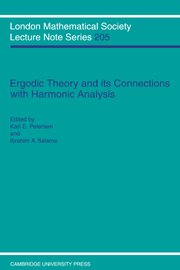Preface
Published online by Cambridge University Press: 24 February 2010
Summary
Ergodic theory is a crossroads for many branches of mathematics and science, from which it has drawn problems, ideas, and methods, and in which it has found applications.
In recent years the interaction of ergodic theory with several kinds of harmonic analysis has been especially evident: in the Fourier method of proving almost everywhere convergence theorems introduced by Bourgain and developed by Rosenblatt, Wierdl, and others; in the application of the real-variable harmonic analysis of the Stein school to ergodic theory by, for example, Bellow, Boivin, Deniel, Derriennic, Jones, and Rosenblatt; in rigidity theory, where Katok, Margulis, Mostow, Ratner, Spatzier, Zimmer, and others blend ergodic theory with dynamics, noncommutative harmonic analysis, and geometry; in the study of singular measures, spectral properties, and subgroups by Aaronson, Host, Méla, Nadkarni, and Parreau, which has furthered the analysis of nonsingular transformations and has led to progress on old problems like the higher-order mixing conjecture; in the structure theory of single transformations, where concepts like rank, joinings, and approximation are helping workers such as del Junco, King, Lemanczyk, Rudolph, and Thouvenot to classify systems, to understand better the important family of Gaussian processes, and to explore the connections among spectral and dynamical properties; in the combinatorics of adic transformations, introduced by Vershik and pursued by Herman, Kerov, Livshitz, Putnam, and Skau, which makes visible the connections between some invariants of dynamical systems and certain C*-algebras, especially those associated with group representations; and in the applications of ergodic theory to combinatorial number theory and Diophantine approximation discovered by Furstenberg and developed also by Bergelson, Hindman, Katznelson, and Weiss, which rely in an essential way on techniques from harmonic analysis and spectral theory.
- Type
- Chapter
- Information
- Ergodic Theory and Harmonic AnalysisProceedings of the 1993 Alexandria Conference, pp. vii - viiiPublisher: Cambridge University PressPrint publication year: 1995



